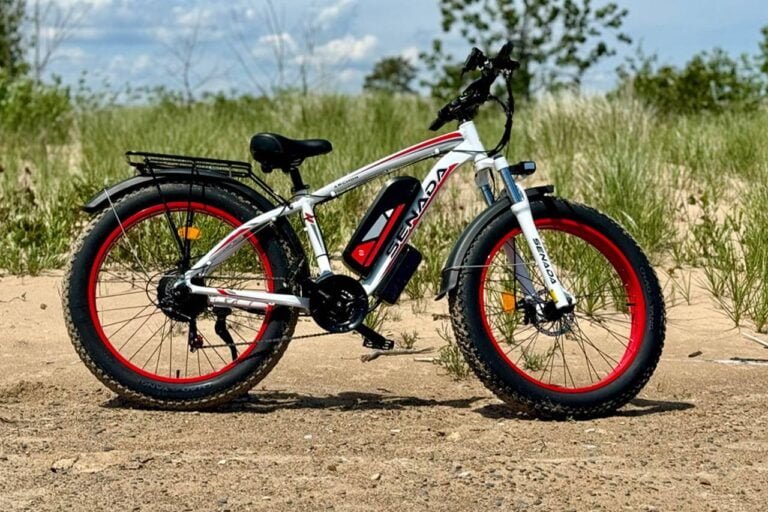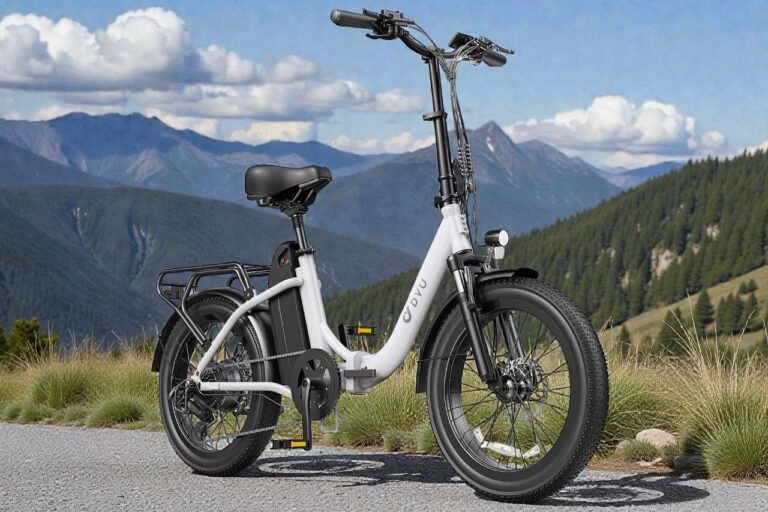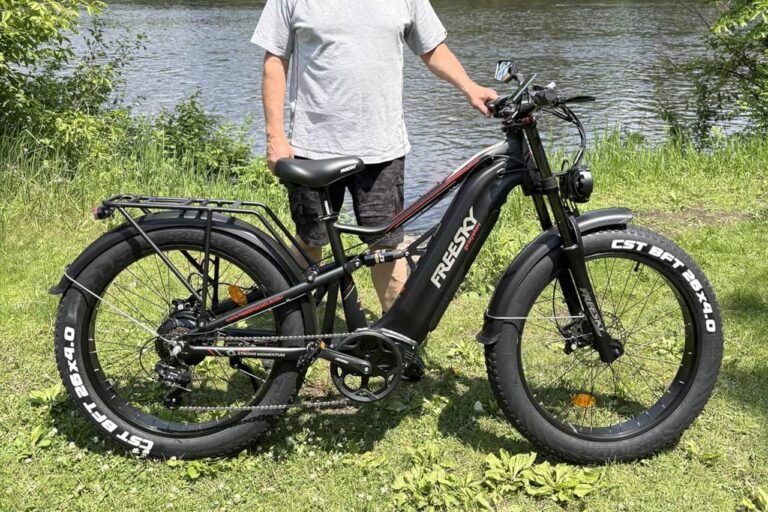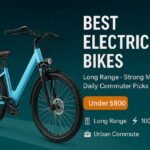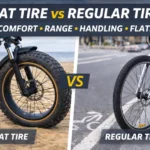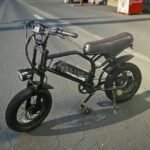
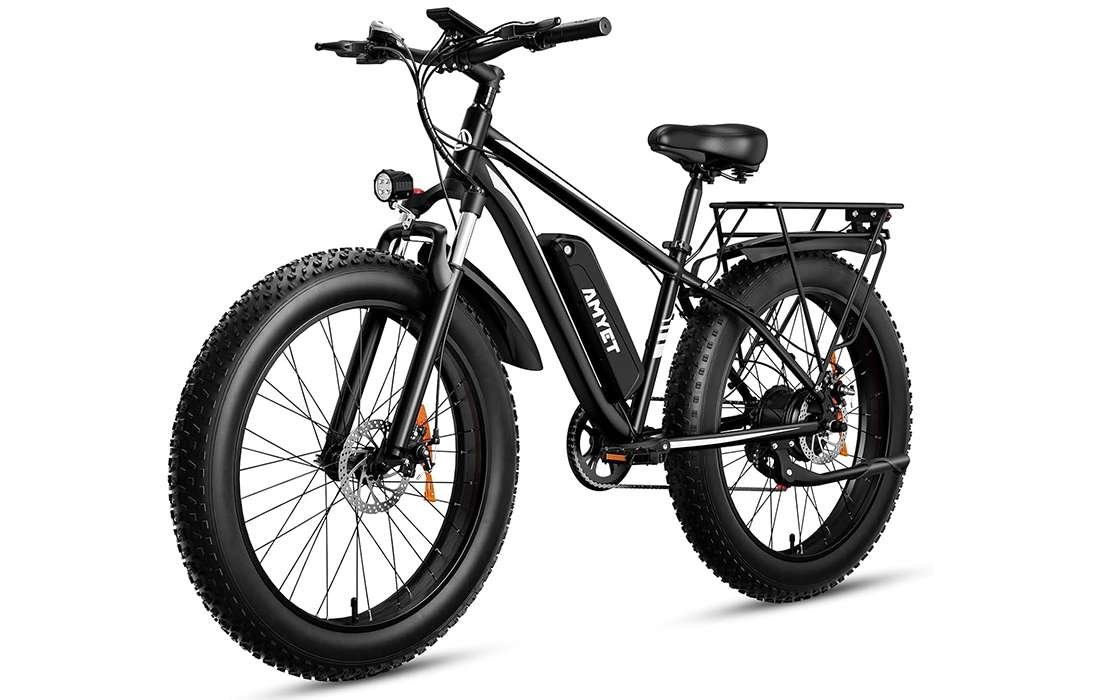
Model A Electric Bike — Balanced Commuter for Daily Rides
Our take: great range and comfort for city riders who want low upkeep and reliable assist.
- 55–80 mi tested range; real-world commuting without range anxiety
- Comfort geometry + front suspension for city & light gravel
- App support, swappable battery; lower lifetime ownership cost
- Motor
- 750W peak
- Battery
- 48V 14Ah
- Top Speed
- 28 mph
- Range
- 55–80 mi
If you’ve been eyeing a full-size fat-tire e-bike that can climb confidently, cruise at commuter speeds, and carry real-world loads without punishing your wallet, the AMYET EB26 deserves a close look. It’s a 26×4-inch hardtail with a burly high-carbon-steel frame, a 48V 15Ah (720Wh) removable battery, and a 1000W (1500W peak) rear hub motor that claims 80Nm of torque and a 28mph top speed. On paper, that’s a lot of bike for a budget-friendly ticket.
Over several weeks I used the EB26 the way most owners will—mixed commuting, weekend trail exploring, a few grocery runs, and some deliberate hill tests. The bike arrived 90% assembled, needed only a basic tool kit to finish up, and settled into daily duty quickly. What stood out first wasn’t a single spec, but how the whole package slots into a sweet spot: big-tire stability, legit power, plug-and-ride accessories, and a frame that feels built for the long haul.
AMYET (under the BFISPORT umbrella) has been in the mobility space for decades and lists a soup of familiar certifications (CE, FCC, RoHS, etc.). The EB26 itself is a pragmatic evolution of the affordable fat-tire template: a simple hardtail chassis, a lockable/adjustable MOZO suspension fork, Zoom mechanical discs, and a Shimano 7-speed drivetrain. There’s nothing exotic here, but the combination is cohesive and, importantly, serviceable with widely available parts.
Is the AMYET EB26 for you?
The EB26 solves a very common need: “I want one bike that does everyday transport, unpaved exploring, winter traction, and light cargo—without constant tinkering or a luxury price.” Its fat 26×4 tires float over potholes, gravel, and sand. The motor has meaningful punch for rolling hills and brisk urban mixing. The rack, fenders, headlight, bell, and kickstand make it commute-ready out of the box.
It’s for riders who value stability and comfort over razor-sharp handling. If you’re 5'4"–6'3" and up to ~330 lb load, the geometry and weight rating suit a wide range of adults, including taller or heavier riders who want a solid chassis under them. Beginners will appreciate the five PAS levels, the throttle option for starts, and a bright LCD that’s easy to read and simple to set.
It’s not for minimalists chasing a sub-50-lb build or mountain bikers wanting true suspension kinematics and high-speed singletrack manners. The EB26 is a heavy, planted hardtail. Likewise, if you insist on hydraulic brakes or torque-sensor finesse right out of the box, you’ll want to budget for upgrades or look higher up the market.
Budget-wise, EB26 lives firmly in the value category. You’re buying capability per dollar, not boutique finishing. That’s the point—and it delivers.
What We Like About the AMYET EB26
Power delivery is the headline. The 1000W hub with a 48V system punches well above many “nominal 750W” peers. On flat ground, PAS 4–5 moves you quickly to mid-20s mph. On our 10% test hill, PAS 5 with modest rider input held 12–14 mph without drama. The motor stays quiet, and heat build-up was a non-issue on repeated climbs.
Range is honest for the capacity. The 720Wh pack nets real-world numbers that match the claims: in cool spring temps, I saw 36–40 miles in mixed PAS 3–4 with occasional throttle bursts, and a best of 54–56 miles by nursing PAS 1–2 on gentle bike paths. That’s squarely in the 36–60 mile window, and enough for most weekly routines with two charges.
The ride quality is forgiving. Fat 4-inch rubber at ~15–18 psi plus a lockable MOZO fork blunt expansion joints and washboarded gravel. The steel frame is sturdy and soaks vibration in a way many aluminum frames don’t. AMYET’s cockpit has a tall stack and an adjustable stem, so you can sit upright and relaxed or drop slightly for headwinds.
Utility is high out of the box. Full fenders, integrated headlight, rear rack, bell, and a kickstand mean zero accessory scramble. The rack is stout enough for panniers or a crate, and the frame triangle still leaves space for a lock or bottle cage solutions. The LCD is IPX4, adds a USB charging port, and shows the right data (speed, ODO, trip, PAS level, max/avg speed).
Servicing is straightforward. The bike uses common standards: 7-speed freewheel, mechanical cable discs, 180mm-class rotors, threaded bottom bracket, and readily available tires and tubes. Cables are external where it matters, which I prefer for field fixes and upgrades.
What We Don’t Like About the AMYET EB26
Weight is real. With rack and fenders installed, my test bike hit 76–77 lb on the scale. That’s normal for the class but worth noting if you’ll carry it upstairs, lift it onto a car rack, or maneuver in tight hallways. The good news: once rolling, the weight translates to stability.
The mechanical brakes work, but you’ll feel them on long descents. Lever travel increases as pads heat, and heavy riders will want to keep the rotors true and cables adjusted. They stop the bike, but hydraulic calipers are on my short list of upgrades for steeper terrain or frequent cargo duty.
Claim language can be confusing. Some marketing visuals mention “dual shock absorber.” To be clear: the EB26 is a hardtail with a front suspension fork—there is no rear shock. Likewise, one spec blurb says “21 speeds (TY-21).” The production bike ships with a 7-speed drivetrain. None of this hurts the ride, but it’s worth clarifying expectations.
The saddle is supportive, not plush. It’s fine for 30–45 minutes, but if you plan 2-hour explorations, add a suspension seatpost or a saddle that better matches your anatomy. The pedals are basic resin. They work; metal pedals with traction pins feel nicer and add confidence in wet shoes.
Finally, there’s no integrated taillight. You do get a bright headlight and reflectors, but commuters should add a USB rear flasher for dusk rides and rainy days.
Pros & Cons
| Pros | Cons |
|---|---|
| Strong 1000W (1500W peak) hub with convincing hill punch | Heavy; ~76–77 lb with rack/fenders |
| 48V 15Ah (720Wh) battery delivers honest 36–60 mile range | Mechanical discs need regular cable tweaks; hydros are nicer |
| Big-tire comfort and stability on mixed terrain | No integrated taillight; add your own rear light |
| Rack, fenders, headlight, bell, kickstand included | Marketing specs can confuse (hardtail, 7-speed) |
| Adjustable MOZO fork, upright cockpit with adjustable stem | Stock saddle and pedals are serviceable, not special |
| 330 lb max load, steel frame inspires confidence | Not for riders seeking a lightweight or nimble XC feel |
| Simple, serviceable parts; easy to upgrade over time |
What’s Included?
- AMYET EB26 e-bike (hardtail steel frame, 26×4 tires)
- 48V 15Ah removable lithium-ion battery with keys
- Battery charger (my unit supplied ~3A; ~4–5 hour charge window)
- Front and rear fenders (pre-painted to match)
- Rear cargo rack with hardware
- Integrated LED headlight (handlebar-controlled)
- Bell and basic horn function through the control cluster
- Kickstand (rear-mount)
- Reflectors (wheels and rear)
- Basic tool kit (Allen keys, multi-wrench, small hardware)
- Pedals, front wheel quick-release skewer, and manuals
- LCD display with USB-A output port
For a value bike, it’s a generous bundle. You can ride to work on day one without a shopping spree for essentials. The only “missing” item I’d flag for commuters is a dedicated taillight; plan to add a bright USB unit. Otherwise, the kit is complete and installation hardware is labeled sensibly.
Technical Specifications
| Specification | AMYET EB26 |
|---|---|
| Motor | 48V 1000W rear hub (1500W peak), ~80Nm claimed |
| Battery | 48V 15Ah (720Wh) removable, downtube-mounted |
| Charger | ~3A (observed); ~4–5 hours from low to full |
| Top Speed | 28 mph stock in PAS; user-adjustable settings allow higher where legal |
| Range | 36–60 miles (PAS-dependent; tested 36–56 miles) |
| PAS Levels | 5 (with throttle override) |
| Display | LCD, IPX4, shows speed/ODO/TRIP/MAX/AVG/PAS; USB port |
| Drivetrain | Shimano 7-speed (freewheel), trigger shifter |
| Brakes | Zoom mechanical discs, 180mm-class rotors |
| Fork | MOZO suspension, lockout & preload adjust |
| Frame | High-carbon steel hardtail, internal/externally routed cables |
| Tires | 26×4.0" all-terrain fat tires |
| Accessories | Headlight, fenders, rear rack, bell, kickstand, reflectors |
| Rider Fit | Recommended 5'4"–6'3"; max load 330 lb |
| Bike Weight | ~76–77 lb as tested with rack/fenders (marketing varies) |
| Water Resistance | IP65 noted for battery; general e-bike rain riding common sense applies |
| Assembly | 90% assembled; typical 30–60 min setup |
| Certificates (as listed) | CE, RoHS, FCC, UL, GCC (listing claims) |
Always verify local Class 2/3 rules before enabling higher speed settings. Ride within legal limits on shared paths.
Features
- 1000W brushless hub motor (1500W peak) for confident acceleration and hill starts.
- 48V 15Ah (720Wh) battery with lock/key removal for off-bike charging and theft deterrence.
- Five PAS levels + throttle so beginners can start easy and experienced riders can cruise fast.
- 26×4 fat tires that float over gravel, snow dustings, beach approaches, and broken pavement.
- MOZO suspension fork with lockout and preload so you can tailor feel for cargo or rider weight.
- Zoom mechanical disc brakes with large rotors and widely available pads/cables.
- Shimano 7-speed drivetrain that’s simple, quiet, and inexpensive to maintain.
- Utility-first accessories: integrated headlight, full fenders, rear rack, bell, kickstand.
- Clear LCD (IPX4) with USB charging, TRIP/ODO/MAX/AVG speed, and PAS readouts.
- High-carbon-steel frame rated to 330 lb and tuned for upright comfort and stability.
- Adjustable stem & saddle height to fit riders from ~5'4" to ~6'3".
- IP65 battery housing and sealed connectors for normal wet-weather riding (avoid submersion).
How do these specs play together? In practice, the EB26 feels like a calm heavyweight with a strong pull when asked. PAS 1–2 is gentle and great for bike paths; PAS 3 is the everyday default around town; PAS 4–5 is where it wakes up for traffic gaps and hills. The fork meaningfully reduces chatter at 12–18 mph on dirt connectors, and fat tires let you run lower pressure for comfort without pinch-flat anxiety. Brakes are adequate if maintained; budget for pads and cable adjustments as part of routine care.
Real-World Riding Notes
Acceleration & Speed: From a standstill, the throttle helps roll smoothly without pedal fumbles. With moderate pedaling, getting to 20–24 mph happens quickly. Above that, you’ll feel wind drag more than motor limit. Cadence at top speed with the stock 7-speed is brisk but manageable; consider a larger chainring if you spin out frequently on long fast sections.
Hill Climbing: On repeated runs up a 10% grade for a quarter mile, the EB26 held over 12 mph in PAS 5 with seated pedaling. On shorter 15% pitches, momentum and a brief stand on the pedals kept it moving. “30° max slope” is a marketing translation; focus on the punchy, usable torque—there’s plenty for daily hills.
Handling & Comfort: The long wheelbase and heavy tires make the EB26 calm. It tracks straight, resists being deflected by potholes, and feels settled with a loaded rear rack. In tight switchbacks or narrow multi-use trails, you’ll steer earlier and slower. Upright ergonomics help visibility and reduce wrist pressure; the adjustable stem is a win for dialing reach.
Noise & Vibration: The hub motor is quiet under load; the loudest sounds are the tires on coarse asphalt and the occasional rattle from fenders if hardware loosens. A drop of threadlocker on the rack and fender fasteners during assembly is time well spent.
Weather: In light rain, the headlight is sufficiently bright for “be seen,” and the fenders do their job. The display stayed visible and the controls didn’t mind wet conditions. As with any e-bike, avoid pressure-washing, keep the charging port dry, and wipe down connectors after wet rides.
Fit & Sizing: At 5'11", I set the saddle slightly above mid and rotated the bars for a neutral wrist angle. Riders nearer 6'3" can extend the post and raise the stem; shorter riders around 5'4" may want to swap to a seatpost with more offset to reduce reach. The 330 lb rating is reassuring for bigger bodies or cargo.
Charging, Battery Care & Range Strategy
The included charger on my unit output around 3 amps, which refilled a low battery in roughly 4–5 hours. If you routinely arrive home with 50% remaining, expect shorter top-ups. Lithium packs live longer when stored between 40–80% and kept above freezing; AMYET’s removable design makes indoor charging easy in winter.
To stretch range, ride PAS 2–3 on flats, reserve PAS 4–5 for hills and headwinds, and keep tire pressures consistent. At 200–220 lb system weight, I averaged ~13–20 Wh/mi depending on terrain, lining up with 36–55+ miles per charge. That’s efficient for a full-size fat-tire machine.
Brakes, Drivetrain & Maintenance
Zoom mechanical discs are dependable and simple to tune. Plan to adjust cable tension as pads wear and bed new pads properly (slow stops from moderate speeds for a dozen repeats). Upgrading cables/housing to low-friction liners improves feel. If your routes include long 30+ mph descents, a budget hydraulic kit (e.g., Zoom HB-876/MTB-kit) is a smart, bolt-on improvement.
The Shimano 7-speed works fine and is quiet with correct limit screw setup. Keep the chain clean and lubed; it dramatically reduces noise and extends cassette/freewheel life. A spare freewheel and chain are inexpensive and easy DIY installs when the time comes.
Assembly & Setup
Unboxing is straightforward: install the front wheel, handlebar/stem, pedals, headlight bracket, and rack/fenders, then align the calipers and true small rotor rubs. Cables were routed smartly, and all hardware bags were labeled. I recommend adding a dab of blue threadlocker to rack and fender bolts and re-torquing after the first 50 miles.
The LCD menu provides access to wheel size, speed limit, PAS behavior, and some advanced parameters. Out of the box the bike behaves like a Class 3-ish PAS machine topping out around 28 mph. Some regions allow a higher limit on private property; others cap PAS or throttle to 20–28 mph. Know your local rules before changing anything.
Upgrades Worth Considering
- Hydraulic brakes: For heavier riders, steep terrain, or frequent cargo, hydros are worth it.
- Suspension seatpost: A Suntour NCX or similar greatly extends comfort on rough chipseal.
- Pedals: Wide alloy pedals with traction pins improve grip, especially in the wet.
- Rear taillight: A bright USB unit keeps you visible; mount to rack with a reflector adapter.
- Tires: The stock rubber is capable; if you ride mostly pavement, a semi-slick fat tire reduces rolling resistance and whir.
These aren’t mandatory on day one, but they unlock “next level” refinement without breaking the value proposition that makes the EB26 attractive.
Who Should Skip It?
If you live in a fourth-floor walk-up, the weight may wear you down. If you’re chasing lively trail handling, a mid-drive hardtail with real geometry and hydraulic brakes will feel better at speed off-road.
And if you want the polish of an integrated taillight, torque sensor, and hydraulic brakes from the factory, there are pricier bikes that tick those boxes—at 1.5×–2× the spend.
The Bottom Line on Value
Measured purely on capability per dollar, the AMYET EB26 is a standout. It delivers big-tire comfort, stout motor torque, honest range, and practical accessories in a package that’s easy to assemble and easier to live with. Yes, it’s heavy and the component spec is intentionally simple—but that’s exactly why it’s durable, upgradeable, and approachable for first-time e-bike owners.
In daily riding, the EB26 just works. It flattens the ride to work, turns gravel connectors from “avoid” to “why not,” and happily carries groceries on the way home. That’s what this category is supposed to do, and the EB26 nails it.
Final Breakdown
9.0/10
The AMYET EB26 earns its score by combining real power and range with everyday usefulness and approachable pricing. It’s not fancy and it’s not light, but it feels solid, rides comfortably, and includes nearly everything you need on day one. With a taillight added and brakes kept in tune—or upgraded to hydraulics—you’ve got a dependable fat-tire workhorse for commuting, errands, and weekend exploring.
I recommend it to riders who want a confident, cushy, do-most-things e-bike with minimal fuss. If you value low maintenance, predictable handling, and honest muscle over boutique flourishes, the EB26 is easy to endorse.


